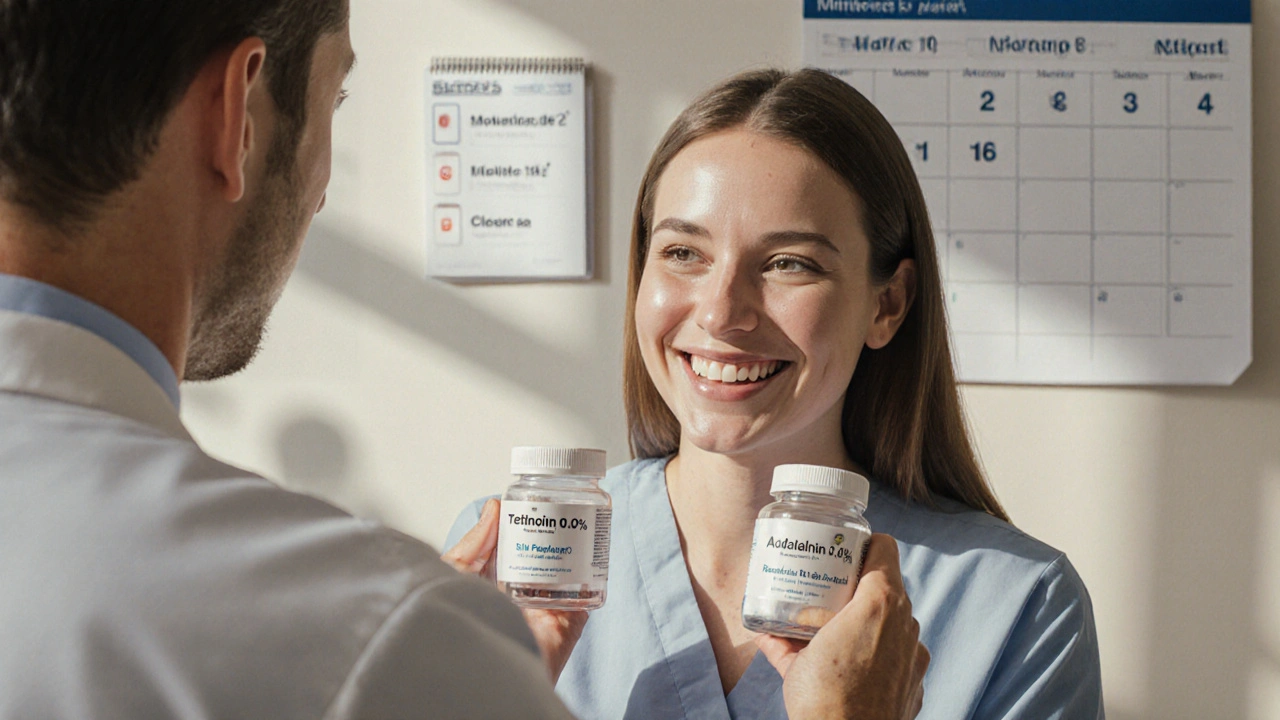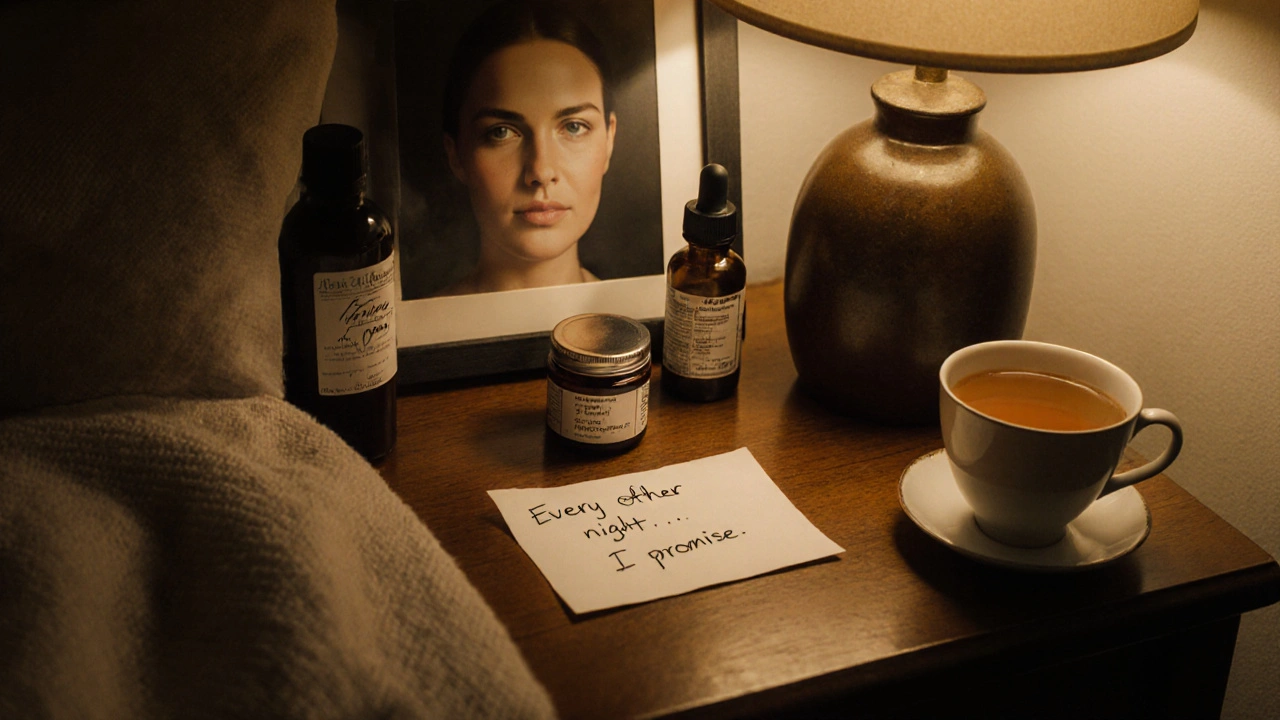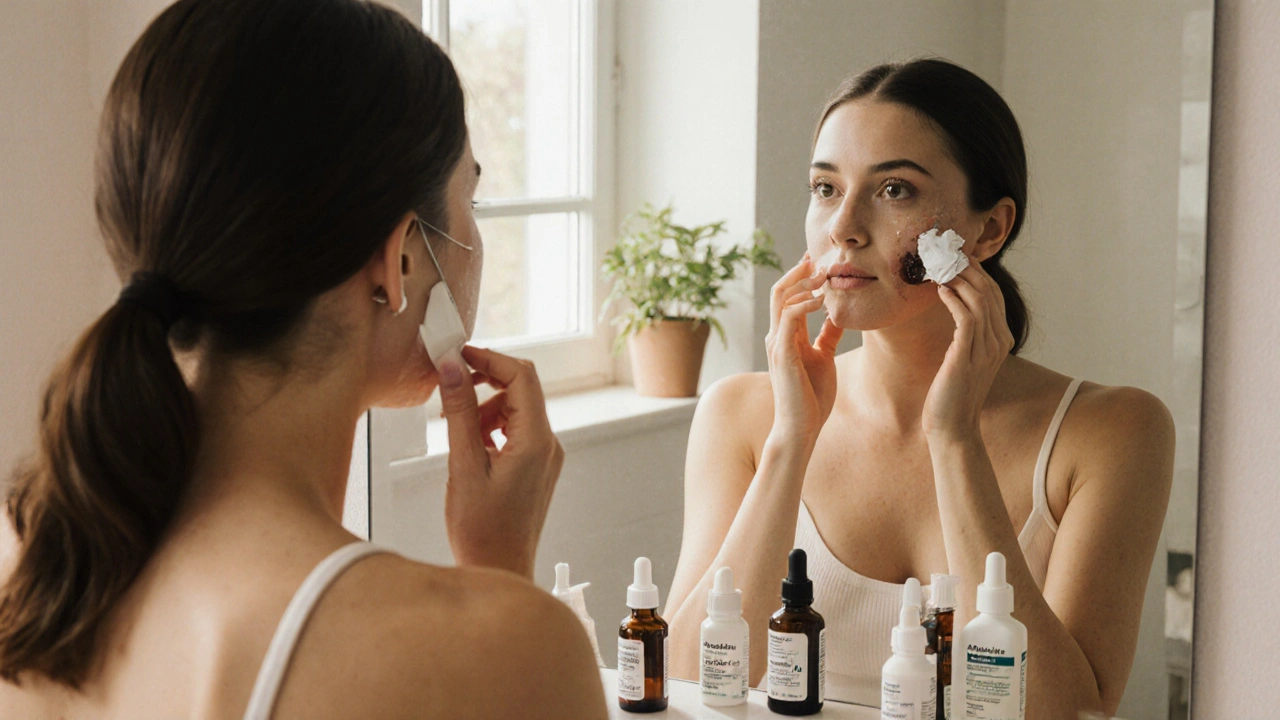Tretinoin Alternative Selector
Find Your Perfect Retinoid Alternative
Answer these questions to get personalized recommendations based on your skin goals and tolerance.
How It Works
This tool analyzes your responses based on dermatologist-recommended guidelines to identify the most appropriate retinoid alternative for your specific needs.
If you’ve been told tretinoin 0.05% is the gold standard for acne and aging skin, you’re not wrong-but it’s not the only option. Many people start with tretinoin, only to quit because of redness, peeling, or irritation. Others never even try it because they’re scared of the side effects. The good news? There are effective, gentler alternatives that work just as well for some people-and sometimes better. This isn’t about replacing tretinoin. It’s about finding what actually works for your skin, without wrecking your barrier.
What tretinoin 0.05% actually does
Tretinoin 0.05% is a prescription-strength retinoid, a derivative of vitamin A. It’s been used since the 1970s and is FDA-approved for both acne and photoaging. At 0.05%, it’s considered a low to mid-strength formula, but don’t let that fool you-it’s potent. It works by speeding up skin cell turnover, unclogging pores, reducing inflammation, and boosting collagen. Studies show it can reduce fine lines by up to 30% after six months and cut acne lesions by 50-70% in 12 weeks.
But here’s the catch: tretinoin doesn’t care if your skin is sensitive. It’s designed to force change. That means dryness, flaking, burning, and redness are common-especially in the first 6-8 weeks. Up to 40% of users stop using it because of irritation, according to clinical trials published in the Journal of the American Academy of Dermatology.
Adapalene 0.1%: The gentle powerhouse
Adapalene is a synthetic retinoid, sold over-the-counter as Differin Gel (0.1%) and by prescription as higher strengths. Unlike tretinoin, adapalene targets inflammation more directly, making it especially effective for inflammatory acne-those red, swollen pimples.
In a 12-week study comparing adapalene 0.1% to tretinoin 0.05%, both reduced acne by about the same amount. But adapalene caused significantly less irritation. Users reported less peeling, burning, and redness. Many dermatologists now recommend starting with adapalene, especially for beginners or those with sensitive skin. It’s also less likely to cause photosensitivity, so you can use it during the day if needed (though nighttime is still best).
One downside? Adapalene doesn’t stimulate collagen as strongly as tretinoin. So if your main goal is reducing wrinkles or improving skin texture, it won’t match tretinoin’s long-term anti-aging results.
Tazarotene: Stronger than tretinoin
Tazarotene is a third-generation retinoid, available as a 0.05% or 0.1% cream or gel. It’s FDA-approved for acne and psoriasis, and it’s actually more powerful than tretinoin in some studies.
A 2019 trial in the British Journal of Dermatology found tazarotene 0.1% reduced acne lesions 20% more than tretinoin 0.05% after 12 weeks. It also showed better results for skin texture and pigmentation. But the trade-off? Higher irritation. Tazarotene is not a beginner-friendly product. If you’ve tried tretinoin and still can’t tolerate it, tazarotene might be too harsh.
It’s often used for stubborn acne, melasma, or severe photoaging-when you need maximum effect and can handle the fallout. Dermatologists usually prescribe it after patients have built up tolerance to milder retinoids.
Retinol: The OTC contender
Retinol is the over-the-counter version of retinoids. It’s not as strong as tretinoin because your skin has to convert it into retinoic acid first-tretinoin is already in its active form.
That conversion process makes retinol slower and less predictable. A 0.3% retinol product might be roughly equivalent to 0.025% tretinoin. To match 0.05% tretinoin, you’d need at least 1% retinol-and even then, results take longer. Studies show retinol improves fine lines after 12-24 weeks, but not as dramatically as tretinoin.
Still, retinol is the go-to for people who want anti-aging benefits without a prescription. Brands like Paula’s Choice, CeraVe, and The Ordinary offer stable, well-formulated versions. If you’re new to retinoids, start here. Build tolerance over 3-6 months, then consider stepping up to tretinoin if you need more.

Azelaic Acid: The non-retinoid alternative
Azelaic acid isn’t a retinoid. It’s a naturally occurring acid found in grains. It’s FDA-approved for acne and rosacea, and it works differently: it kills acne bacteria, reduces inflammation, and fades dark spots.
In a head-to-head trial with tretinoin 0.05%, azelaic acid 20% (available by prescription as Finacea) reduced acne just as effectively-but with far less irritation. It’s also safe during pregnancy, which tretinoin is not. People with rosacea, sensitive skin, or melasma often prefer azelaic acid because it calms redness instead of aggravating it.
The downside? It doesn’t boost collagen or speed up cell turnover like retinoids. So while it clears acne and evens tone, it won’t firm skin or reduce deep wrinkles. It’s a great companion to retinoids, or a solid standalone for those who can’t use them at all.
Isotretinoin: The nuclear option
Isotretinoin (Accutane) is an oral retinoid, not topical. It’s reserved for severe, cystic acne that hasn’t responded to other treatments. It’s not an alternative to tretinoin 0.05%-it’s a completely different tool.
Isotretinoin reduces oil production by up to 90%, shrinks sebaceous glands, and clears acne in 80-90% of patients after one course. But it comes with serious risks: dry skin, mood changes, birth defects, and liver stress. It requires monthly blood tests and strict birth control for women.
It’s not something you try because tretinoin irritated your skin. It’s for when acne is destroying your confidence and other treatments have failed. If you’re considering isotretinoin, you need to see a dermatologist-not just for the prescription, but for the monitoring.
Which alternative is right for you?
There’s no universal best. Your choice depends on your skin type, goals, and tolerance.
- Start with adapalene 0.1% if you’re new to retinoids or have sensitive skin. It’s the safest gateway.
- Stick with tretinoin 0.05% if you’ve tolerated it before and want maximum anti-aging and acne results.
- Try azelaic acid if you have redness, rosacea, or melasma, or if you’re pregnant or breastfeeding.
- Use retinol if you want OTC anti-aging without a prescription and don’t mind waiting 6+ months for results.
- Consider tazarotene only if you’ve tried tretinoin and still need stronger results-and can handle the side effects.
Many people combine treatments. For example: use adapalene at night, azelaic acid in the morning. Or use tretinoin twice a week and retinol the other nights. Layering isn’t always better, but strategic rotation can help you get results without burning out your skin.

What to avoid
Don’t mix tretinoin with other strong actives like benzoyl peroxide, salicylic acid, or glycolic acid in the same routine-especially at first. These can make irritation worse. Use them on alternate nights. Don’t use more than one retinoid at a time. And never use tretinoin with physical scrubs or harsh exfoliants. Your skin barrier is fragile during the adjustment phase.
Also, skip the “retinol creams” that contain less than 0.1% retinol. Those are essentially placebos. Look for products with at least 0.3% retinol, preferably in airless, opaque packaging to keep it stable.
How long does it take to see results?
Patience is non-negotiable. Tretinoin and its alternatives don’t work overnight.
- Acne: 4-8 weeks for initial improvement, 12-16 weeks for clear skin.
- Texture and fine lines: 3-6 months for noticeable change, 12 months for best results.
Most people quit too early. If you’re still peeling at week 6, that’s normal. Don’t stop. Scale back to every other night. Add a gentle moisturizer. Stick with it. The skin resets around the 3-month mark. That’s when the real magic happens.
Final thought: It’s not about the strongest-it’s about the sustainable
Tretinoin 0.05% is powerful. But so are the alternatives. The best treatment isn’t the one with the highest concentration. It’s the one you’ll use every night for a year. If tretinoin makes your skin feel like sandpaper, it doesn’t matter how good the science says it is. If adapalene gives you clear skin without drama, that’s the winner.
Your skin isn’t a lab. It’s your body. Listen to it. Adjust. Experiment. And remember-consistency beats potency every time.
Can I use tretinoin 0.05% every night?
You can, but most people shouldn’t start there. Begin with every other night, or even twice a week, especially if you have dry or sensitive skin. Wait until your skin adjusts-usually after 4-8 weeks-before increasing frequency. Using it daily too soon can cause severe irritation and damage your skin barrier.
Is adapalene as good as tretinoin for wrinkles?
Adapalene helps with fine lines and skin texture, but not as much as tretinoin. Tretinoin has stronger evidence for boosting collagen and thickening the dermis over time. If anti-aging is your main goal, tretinoin still wins. But for mild signs of aging and acne-prone skin, adapalene is a great, gentler choice.
Can I use retinol instead of tretinoin?
Yes, but expect slower results. Retinol is about 20 times weaker than tretinoin because your skin must convert it. A 1% retinol product might match 0.025% tretinoin. To get close to 0.05% tretinoin, you’d need 1.5-2% retinol-and even then, results take longer. Retinol is ideal for beginners or those avoiding prescriptions.
Does azelaic acid work for acne like tretinoin?
Yes-for inflammatory acne. Azelaic acid kills acne bacteria and reduces redness, making it just as effective as tretinoin for papules and pustules. But it doesn’t unclog pores or increase cell turnover like retinoids. So if you have blackheads or clogged pores, tretinoin will work better. Azelaic acid is best for red, irritated acne or melasma.
What’s the best way to apply tretinoin or its alternatives?
Use a pea-sized amount for your entire face. Apply it to dry skin-wait 20 minutes after washing. Start with a thin layer, then follow with moisturizer. Never apply it to wet skin or right after exfoliating. Use it at night, and always wear sunscreen in the morning. Avoid the eyes, lips, and corners of the nose.
If you’ve tried tretinoin and gave up, don’t assume retinoids don’t work for you. You just haven’t found the right one yet. The skin care world has more options than ever. The goal isn’t to find the strongest product. It’s to find the one your skin will thank you for using tomorrow-and next year.







ridar aeen
31 October 2025Adapalene changed my life. I tried tretinoin for 3 weeks and looked like a lobster that got into a fight with a scrub brush. Switched to Differin, barely noticed anything at first, then-boom-clear skin at 8 weeks. No burning, no peeling, just quiet progress. I’m 32 and my skin hasn’t looked this good since high school. Why suffer when you don’t have to?
Samuel Wood
1 November 2025Ugh. So many ppl think OTC stuff is ‘just as good’ but c’mon. Tretinoin 0.05% is the OG for a reason. Adapalene? Cute. Retinol? A glorified moisturizer with a fancy label. If you’re not seeing real collagen remodeling after 6 months, you’re not doing it right. Stop coddling your skin like it’s a baby. Real results require real irritation. #NoPainNoGain
chantall meyer
2 November 2025Let’s be real-most people don’t need tretinoin at all. Azelaic acid is the unsung hero. I had melasma from pregnancy and hormonal acne. Tretinoin made my face look like a sunburned potato. Azelaic acid? Calmed everything. Faded spots. No drama. And it’s safe while breastfeeding. Why are we still treating skin like a battlefield? Gentler doesn’t mean weaker. It means smarter.
Will RD
3 November 2025Retinol is a scam if it’s under 1%. Most brands put 0.01% and call it ‘anti-aging.’ Wake up. Also, don’t mix with niacinamide. It ruins everything. Just use tretinoin. Everything else is just marketing.
Jacqueline Anwar
4 November 2025It’s astonishing how many individuals mistake tolerance for efficacy. The notion that ‘gentler’ equates to ‘better’ is not only scientifically unsound-it’s dangerously misleading. Tretinoin’s clinical superiority in dermal thickening and collagen induction is empirically documented across decades. To substitute it with OTC alternatives out of fear is not self-care; it’s self-sabotage. Your skin does not need coddling. It needs stimulation.
Ganesh Kamble
4 November 2025Bro tretinoin is just vitamin A but with a prescription label. Why pay $100 a tube when you can get retinol for $15 and just wait 6 months longer? Also, who even uses azelaic acid? That’s for people who still cry when they wash their face. Just use benzoyl peroxide and call it a day. Everything else is influencer BS.
Jenni Waugh
5 November 2025Let me tell you something-your skin is not a lab rat. I used tretinoin for 10 months and ended up with a barrier so broken I looked like a lizard shedding. Then I tried azelaic acid + adapalene 2x a week. My skin didn’t just heal-it thrived. I’m not ‘giving up.’ I’m upgrading. And guess what? My dermatologist gave me a standing ovation. 💪✨
Theresa Ordonda
7 November 2025Okay but has anyone tried combining adapalene with niacinamide? I did it after my tretinoin meltdown and my skin went from ‘red disaster’ to ‘glowy angel’ in 3 weeks. Also, moisturizer before retinoid? Game changer. 🙌 I used to think you had to suffer to glow. Nope. Just be smart. And yes, I’m now a full-time retinoid nerd. 😎
Judy Schumacher
8 November 2025While the article presents a superficially comprehensive overview, it fundamentally misrepresents the pharmacodynamic hierarchy of retinoids. The assertion that ‘consistency beats potency’ is not merely reductive-it is antithetical to the established dermatological canon. Tretinoin 0.05% remains the only topical agent with Level I evidence for both acne resolution and dermal remodeling. The substitution of weaker analogues, while psychologically comforting, constitutes a therapeutic compromise of measurable clinical consequence. One cannot achieve photorejuvenation through compromise. The skin does not reward timidity. And to suggest that azelaic acid ‘fades spots’ as effectively as tretinoin is to ignore the fact that the latter alters gene expression in fibroblasts while the former merely masks inflammation. This is not skincare. This is self-deception dressed in colloquialism.